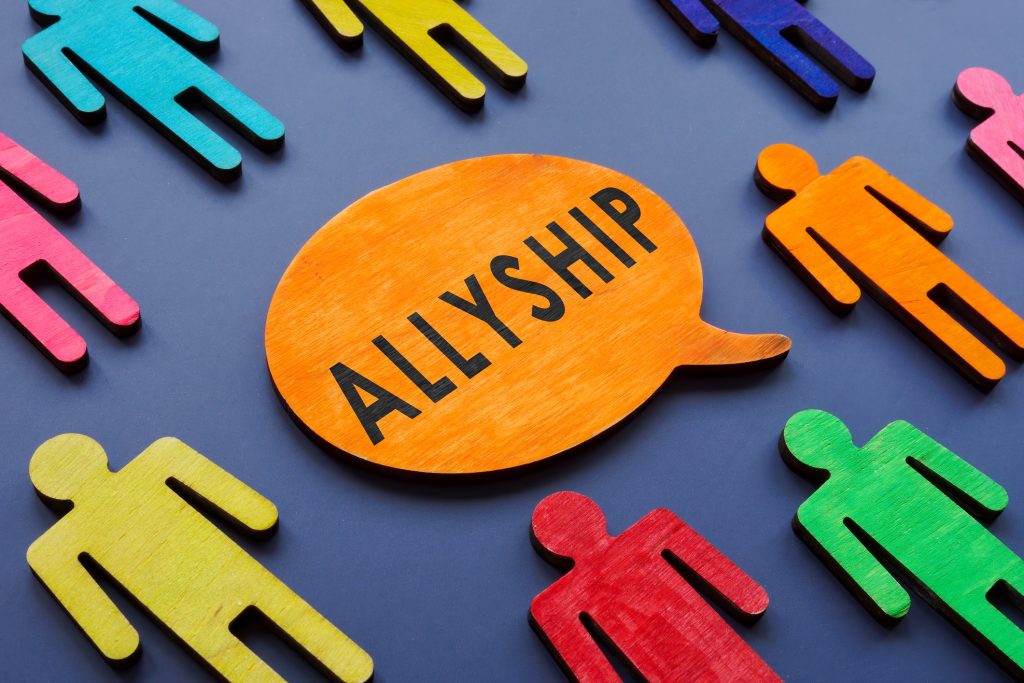How To Be An Authentic Ally At Work
RECRUITMENT • Oct 20, 2021

Has there ever been a better time to show up and become an ally at work? We don’t think so. While we’re all finally becoming accustomed to having difficult conversations about equality, diversity and inclusion, it still seems to be an issue many workplaces only reluctantly add to the bottom of their ‘to do’ list. A recent report concluded that only 27% of people surveyed felt that inclusion was a strong part of their company’s culture and values, and only 22% of leaders stated that they actively challenge themselves and others to recognise and eliminate biases. This indicates that far too many people are content with the status quo, which we know is still far from satisfactory – the UK is still battling an ethnicity pay gap, and LGBTQ+ employees are still far more likely to face harassment than their colleagues.
The Rochester Racial Justice Toolkit defines allyship not as an identity, but as a process of building relationships based on consistency, accountability and trust with marginalised individuals and groups. Importantly, they also point out that true allyship comes from a place of solidarity, and that it is not an award to be won, rather a privilege to be earned. That means it takes effort, practise and commitment. Unfortunately, it’s infinitely easier to call yourself an ally than it is to behave like one. That’s because it isn’t always easy – amplifying marginalised voices and calling out injustice won’t always make you popular, especially if your attitude is at odds with management. With these things in mind, let’s take a look at five ways anyone can begin to become an authentic ally in the workplace.
1. Listen, and learn
Perhaps most importantly of all, you must first try to understand the true lived experience of marginalised groups, which means educating yourself. You might think, from a place of true compassion, that a good place to start is to ask questions. However, marginalised people are not required to educate you, no matter how desperately or genuinely you want to learn, and may also already be carrying a heavy enough burden of their own. So, be proactive – check to see if your company has made any relevant educational resources available, seek out groups within your local area to get involved with, and make use of the incredible amount of information available to you online. Moreover, if people do decide to share their experiences with you, listen wholeheartedly, without becoming defensive. This might involve conceding that some pre-conceived notions you had were incorrect, or that some of your past actions were wrong. If that’s the case, it’s okay to admit it, and resolve to do better in the future.
2. Don’t make it about you
No part of becoming a workplace ally involves placing yourself at the centre of the story. People experiencing discrimination don’t need to be ‘rescued’ by you, so don’t be tempted to position yourself as their knight in shining armour. Although it’s great to use whatever platforms you have to draw attention to injustice, speaking up for the exclusive purpose of boosting your social capital is known as performative allyship, and can do far more harm than good. If you’re only making your opinion on important issues known through social media, but remain silent in real life, it’s time to start questioning your own motivations.
In addition, when it comes to issues of racial equality and injustice, you cannot become an ally if you’re at pains to point out that you personally are not racist, and that not all white people are racist – all you’re achieving is derailing the conversation in order to feel better about yourself, along with denying the existence of systemic racism. Such defensiveness when faced with uncomfortable issues is indicative of white fragility, and is a blocker to important and productive discussions. If you’re white, part of becoming an authentic ally to colleagues within racial minority groups is accepting your privilege and seeking ways you can use it to creative positive change, rather than denying it.
3. Advocate, and amplify!
As the old saying goes, be the change you want to see in the world. Work is a great place to advocate on behalf of marginalised communities, because statistically, this is where most discrimination occurs. For instance, you could make an effort to find out more about your company’s internal DI&E policies, if you’re able to. Start with recruitment and selection – a topic very close to our own hearts – are you using inclusive language in your job descriptions? Are you removing names and ages from CVs? Are you allowing for reasonable adjustments at every stage of the process? Every so often, every company should conduct a forensic analysis of how bias might be sneaking in. You might also pay more attention to whose voices are being heard in meetings – are the opinions of your disabled colleagues being dismissed more frequently? Do black employees seem more hesitant to speak up than their white counterparts? Additionally, it can be helpful to take a closer look at performance management, to see if there are any concerning trends; which staff are being rated more highly? Is any particular group being disciplined more frequently?
In addition, make an effort to amplify voices that aren’t normally heard. This might involve tactfully interjecting on behalf of colleagues by engaging them in conversations, and giving them an opportunity to voice their opinions. If you work in a senior position, your capacity to do this is even greater. For instance, think of something that a team member from a marginalised community has taught or shown you, and find an opportunity to point it out in front of others at times when it will make the most impact. This is an ally taking on the role of the ‘sponsor’, and placing the marginalised person firmly in the limelight. You might also consider recommending these team members for special assignments or learning opportunities.
4. Challenge stereotypes, and speak up (not over)
It can often be difficult for people within a marginalised group to speak up when they find themselves on the receiving end of prejudice and discrimination, especially when it’s subtle, because they don’t want to seem like they’re ‘making a fuss’ or ‘being too sensitive’. For instance, you might hear one of your colleagues loudly assume that your 60+ co-worker doesn’t know how to use social media, or won’t be capable of learning how a new platform works. Whilst these comments might seem annoying yet relatively harmless, when people experience microaggressions such as these on a daily basis, it can be incredibly difficult to deal with. Not only that, when one person behaves in this manner, it can easily spread, which can take a real psychological toll on the mental health of the recipient. This can lead to anger and depression, which can contribute to issues with performance and productivity at work. Your job as an ally, therefore, is to speak up the next time you notice someone is on the receiving end of microaggressions; just a simple, “that’s not funny” or “I don’t think that’s appropriate” can be enough to make the speaker reconsider what they’re saying, and choose to take a different approach next time. And remember, an ally’s job is to provide support, and use their position to call out injustices and educate others, but in a way that doesn’t speak over those they’re trying to support. So, don’t be afraid to call out unhelpful behaviour, but ensure you know when to step back and allow marginalised community members to take centre stage.
5. Take action, and be courageous
Celebrations such as Black History Month are a brilliant time to suggest your company becomes more outspoken in its support of black voices on your social media channels, or that you hold events to demonstrate support and solidarity. Even now, some companies feel that taking part in celebrations such as these is ‘too controversial’ and will ‘upset someone’ – it’s your job as an ally to fight against these outdated attitudes with every fibre of your being! Remember to also keep an eye on the calendar for any awareness days which are commonly overlooked, or even issues which are still somewhat taboo such as mental health struggles, and speak up wherever you can. If your workplace values Corporate Social Responsibility (as it should) then try to use your influence to suggest you contribute to programmes tailored specifically to help marginalised communities. Alternatively, donating your own free time as a resource can be just as valuable.
Part of being an authentic ally is also sticking by your values even when it becomes more difficult. If you’re looking for a job, don’t forget to ask about what your potential new employer is doing in terms of equality, diversity, and exclusion. You might also consider asking how many senior positions are held by people from marginalised communities. If they struggle to answer, as an ally, that’s a clear signal that it’s time to vote with your feet and move along. Additionally, if clear discrimination is taking place at work and nothing is being done about it, muster your courage and make a stand – you’ll probably be surprised how many others will follow.
Looking for the right place to become an authentic ally at work? We’ve hundreds of positions available in industries such as accountancy, human resources, marketing and digital, IT, and many more. Alternatively, you can search all our positions here, or register with us.






